Morphodynamics, Genesis, and Anthropogenically Modulated Evolution of the Elfeija Continental Dune Field, Arid Southeastern Morocco
Abstract
1. Introduction
2. Materials and Methods
2.1. Study Area
2.2. Data Acquisition and Processing
2.2.1. Remote Sensing Data and Digital Terrain Model (DTM)
- Primary Morphological Data: Very high-resolution (VHR) satellite imagery (30 cm resolution, primarily from December 2022), accessed via the Google Earth Pro platform, served as the primary dataset for detailed morphological mapping. This imagery enabled precise dune field delineation, the identification of dune types, and the measurement of key morphometric parameters. Fine-scale topographic profiles were also extracted using the platform’s altimetric tools to analyze local variations in altitude and slope.
- Foundational Topographic Data: For the broader topographic context, the NASA Digital Elevation Model (NASADEM) was utilized. Specifically, the SRTMGL1 (Version 1) product provided a foundational digital terrain model (DTM) with a 1 arc-second (~30-m) resolution for the entire study area.
- Multispectral and Thermal Analysis: To analyze land cover and surface dynamics, data from two satellite systems were acquired for May 2024:
- -
- Sentinel-2 (ESA): Multispectral imagery was used to discriminate vegetation and land cover. A false-color composite (SWIR2, NIR, and Green bands) was generated following atmospheric correction to highlight variations between bare sand, sparse vegetation, and irrigated crops.
- -
- Landsat 8/9 (NASA/USGS): Thermal infrared data from the onboard Thermal Infrared Sensor (TIRS) were used to map surface temperature, providing a proxy for assessing soil moisture and the impact of irrigation.
- Field Validation: The remote sensing analyses were validated through targeted in situ observations. These campaigns included ground truthing of the land cover classifications and a direct sand flux measurement experiment conducted on a representative barchan dune within Zone Z3.
2.2.2. Wind Data and Aeolian Regime Characterization
2.2.3. Sampling and Sedimentological Analyses
2.3. Detailed Morphological and Morphometric Analysis
2.4. Aeolian Dynamics Modeling
3. Results
3.1. Aeolian Dynamics
3.1.1. Wind Regime Characteristics
3.1.2. Sand Flux and Collision Probability
3.2. General Morphology, Characteristics, and Cartography of the Elfeija Dune Field
3.2.1. Topographic Profiles
3.2.2. Dune Forms and Morphometric Parameters
3.3. Morphodynamic Zonation of the EDF
- Zone Z1 (0–3.3 km): This upstream zone, with altitudes from 785 m to 795 m (10 m elevation difference, mean slope 0.3%, and max slope 12%), acts as the primary sediment source area for the EDF. As depicted in Figure 5a, which shows the initiation area of the dune field, this zone is characterized by the initial detachment of sand accumulations into individualized barchanoid bodies. These often advance as sand sheets (chasse-sable), primarily composed of darker-toned, likely Fe-Mg-rich materials, derived from alluvial fan deposits such as those of Bou Rbia and Oued Sfissifa. Barchans, emerging from these sand sheets, are the dominant morphodynamic motif in this zone.
- Zone Z2 (3.3–7.7 km): This central zone shows significant altimetric variation (770–785 m, mean slope 0.35%, and max slope 24%). Barchan ribbons from Z1, initially oriented N120–130° E, undergo a localized 30° E deviation before returning to their original orientation. Coalescent barchans form successive, irregular, or imperfect convex arcs, particularly in the southern part of this zone (circumference L = 700–1300 m, mean radius R = 800 m, central angle θ = 85°, and sagitta = 220–230 m in N62° E direction). Figure 5b shows disorganized barchans under torrential flow effects, and Figure 5c depicts barchan fusion/collision. Figure 5d shows the transition from barchanoid ribbons to isolated, disorganized dunes influenced by vegetation and slope changes.
- Zone Z3 (7.7–11.9 km): This downstream zone exhibits lower altimetric variation (770–762 m, mean slope 0.28%, and max slope 5.5%). As illustrated in Figure 5e, simple or isolated barchans become more frequent in this zone, contrasting with more coalesced forms observed further upstream. Their color also tends to change from dark brown to lighter beige, suggesting qualitative granulometric sorting. The interdune areas in this zone are often extensive and marked by numerous linear tracks. Zone Z3 is characterized by an indented northern margin (P = 10%) and extensive agricultural land use, which appears to impede dune progression. Interdune corridors are more developed, with the most significant one (approx. 3 km long, N120° E) connecting the Oued Steila alluvial fan to the Oued Elfeija. Dune wavelength here reaches a maximum of λ = 130 m and locally up to 400 m. Moreover, certain sections of the El Feija wadi show the emergence of dune shields, which evolve into barchans (Figure 5f).
3.4. Dune Density and Sand Encroachment
3.4.1. Dune Density
3.4.2. Dune Occupancy Rate and Sand Encroachment Surface
3.5. Geochemical and Textural Characterization of Dunal Geo-Materials
3.5.1. Grain-Size Distribution
3.5.2. Bulk Mineralogical Composition
3.5.3. Clay Mineral Assemblage
3.6. Land Use and Human Activities
- Dominance of arid zones (pink tones for bare, sterile soil).
- Numerous rectangular plots of bright green (irrigated agriculture, likely watermelon), with some intra-parcel variability (lighter green/yellowish, indicating variations in vegetation density or hydric stress).
- Orange and brown zones (sparse vegetation, likely natural rangeland, or less dense crops) are predominantly at the basin’s edges. The heart of the EDF appears as homogeneous pink (bare, mobile sand) with a WSW-ENE orientation, indicating limited biological activity. A progressive transition to mixed pink and light orange (sparse vegetation) is observed on the southern border of the EDF, a likely sand source area.
- The northeastern border, in direct contact with agricultural plots, represents the active dunal front. Qualitatively, the EDF’s natural vegetation cover is sparse, mainly outside wadi beds and small valleys, consistent with HCEF [27] descriptions of Tamarix, Zygophyllum gaetulum, Pulicaria crispa, Hammada scoparia, and Acacia tortilis subsp. raddiana communities.
3.7. Hypotheses on EDF Genesis and Evolution
4. Discussion
4.1. Controls on Dune Field Morphology and Dynamics
4.2. Sediment Provenance and Pathways
4.3. Regional Context: The EDF in Comparison to Other Moroccan Dune Fields
4.4. Genesis, Holocene Evolution, and Anthropogenic Modulation
5. Conclusions
- The EDF is an active, elongated (WSW-ENE) system of approximately 30 km2, primarily composed of barchans and their coalescent forms, indicating a dominant unidirectional or narrowly bimodal wind regime and active sediment transport. A clear morphodynamic zonation (Z1, Z2, and Z3) reflects sediment pathways from source areas to more organized downwind sectors.
- Aeolian dynamics are significant, with a high dune density (80–90 dunes/km2 in active areas) and a calculated potential sand flux of 1.7 kg/m2/s. The estimated dune collision probability of 32% underscores the constant interaction and reorganization within the field.
- The genesis of the EDF is strongly linked to a Venturi effect within the Feija of Zagora, creating localized conditions favorable for sand accumulation. The estimated age of approximately 1000 years suggests an initiation possibly related to climatic shifts during the Medieval Climatic Optimum.
- Increasing anthropogenic pressure, notably the expansion of irrigated watermelon cultivation, is a significant factor influencing the EDF’s margins, altering land cover, local humidity, and potentially acting as sediment traps or sources, thereby modifying the natural dunal dynamics.
Author Contributions
Funding
Data Availability Statement
Acknowledgments
Conflicts of Interest
References
- Lancaster, N. Geomorphology of Desert Dunes, 2nd ed.; Routledge: London, UK, 2023. [Google Scholar] [CrossRef]
- Lancaster, N. Sand Seas and Dune Fields. In Treatise on Geomorphology; Shroder, J.F., Ed.; Academic Press: San Diego, CA, USA, 2013; Volume 11, pp. 219–245. [Google Scholar] [CrossRef]
- Bishop, M.A. Dune field development, interactions and boundary conditions for crescentic and stellate megadunes of the Al Liwa basin, the Empty Quarter. Earth Surf. Process. Landf. 2013, 38, 89–101. [Google Scholar] [CrossRef]
- Andreotti, B.; Fourrière, A.; Ould-Kaddour, F.; Murray, B.; Claudin, P. Giant aeolian dune size determined by the average depth of the atmospheric boundary layer. Nature 2009, 457, 1120–1123. [Google Scholar] [CrossRef] [PubMed]
- Gunn, A.; Casasanta, G.; Di Liberto, L.; Falcini, F.; Lancaster, N.; Jerolmack, D. What sets aeolian dune height? Nat. Commun. 2022, 13, 2626. [Google Scholar] [CrossRef] [PubMed]
- Kocurek, G.; Havholm, K.G.; Deynoux, M.; Blakey, R.C. Amalgamated accumulations resulting from climatic and eustatic changes, Akchar Erg, Mauritania. Sedimentology 1991, 38, 751–772. [Google Scholar] [CrossRef]
- Goudie, A. Aeolian Anthropocene. In Landscapes of the Anthropocene with Google Earth; Springer: Cham, Switzerland, 2023; pp. 221–237. [Google Scholar] [CrossRef]
- Li, X.; Yan, P.; Liu, B. Geomorphological classification of aeolian-fluvial interactions in the desert region of north China. J. Arid Environ. 2020, 172, 104021. [Google Scholar] [CrossRef]
- Zabuz, T.A. A review of field methods to survey coastal dunes-Experience based on research from South Baltic coast. J. Coast. Conserv. 2016, 20, 175–190. [Google Scholar] [CrossRef]
- Shao, M.; Luo, W.; Che, X.; Hesp, P.A.; Bryant, R.G. UAV SfM based field quantification of barchan dune celerity and morphodynamics in Gonghe basin. Earth Surf. Process. Landf. 2024, 49, 2380–2404. [Google Scholar] [CrossRef]
- Claudin, P.; du Pont, S.C.; Narteau, C. From lab to landscape-scale experiments for the morphodynamics of sand dunes. C. R. Phys. 2024, 25, 267–295. [Google Scholar] [CrossRef]
- Marvin, M.C.; Lapôtre, M.G.A.; Gunn, A.; Day, M.; Soto, A. Dune interactions record changes in boundary conditions. Geology 2023, 51, 947–951. [Google Scholar] [CrossRef]
- Bagnold, R.A. The Physics of Blown Sand and Desert Dunes; Springer: Dordrecht, The Netherlands, 1974. [Google Scholar] [CrossRef]
- Pye, K.; Tsoar, H. Aeolian Sand and Sand Dunes; Springer: Berlin/Heidelberg, Germany, 2009. [Google Scholar] [CrossRef]
- Muhs, D.R. Evaluation of simple geochemical indicators of aeolian sand provenance: Late quaternary dune fields of North America revisited. Quat. Sci. Rev. 2017, 171, 260–296. [Google Scholar] [CrossRef]
- Zhu, B.Q.; Zhang, J.X.; Sun, C. Physiochemical characteristics, provenance, and dynamics of sand dunes in the arid Hexi corridor. Front. Earth Sci. 2021, 9, 728202. [Google Scholar] [CrossRef]
- Bristow, C.S.; Duller, G.A.T. Structure and chronology of a star dune at Erg Chebbi, Morocco, reveals why star dunes are rarely recognized in the rock record. Sci. Rep. 2024, 14, 53485. [Google Scholar] [CrossRef]
- Williams, M. Interactions between fluvial and eolian geomorphic systems and processes: Examples from the Sahara and Australia. CATENA 2015, 134, 4–13. [Google Scholar] [CrossRef]
- Fryberger, S.G.; Dean, G. Dune forms and wind regime. In A Study of Global Sand Seas; US Government Printing Office: Washington, DC, USA, 1979; pp. 137–169. [Google Scholar]
- Owen, P.R. Saltation of uniform grains in air. J. Fluid Mech. 1960, 20, 225–242. [Google Scholar] [CrossRef]
- Durán, O.; Parteli, E.J.R.; Herrmann, H.J. A continuous model for sand dunes: Review, new developments and application to barchan dunes and barchan dune fields. Earth Surf. Process. Landf. 2010, 35, 1591–1600. [Google Scholar] [CrossRef]
- Hersen, P.; Douady, S. Collision of barchan dunes as a mechanism of size regulation. Geophys. Res. Lett. 2005, 32, L21403. [Google Scholar] [CrossRef]
- Jarvis, P.A.; Narteau, C.; Rozier, O.; Vriend, N.M. The probabilistic nature of dune collisions in 2D. Earth Surf. Dyn. 2023, 11, 803–815. [Google Scholar] [CrossRef]
- Grohmann, C.H.; Garcia, G.P.; Affonso, A.A.; Albuquerque, R.W. Dune migration and volume change from airborne LiDAR, terrestrial LiDAR and Structure from Motion-Multi View Stereo. Comput. Geosci. 2020, 143, 104569. [Google Scholar] [CrossRef]
- Boemke, B.; Turki, I.; Brüll, C.; Lehmkuhl, F. Assessing complex aeolian dune field morphology and evolution with Sentinel-1 SAR imagery-Possibilities and limitations. Aeolian Res. 2023, 62, 100876. [Google Scholar] [CrossRef]
- Darke, I. Dynamic coastal dune restoration and spatial-temporal monitoring at the Wickaninnish dunes, Pacific Rim National Park Reserve, British Columbia, Canada. Ph.D. Thesis, University of Victoria, Victoria, BC, Canada, 2018. Available online: https://dspace.library.uvic.ca/server/api/core/bitstreams/7bf58369-3f13-4b29-81db-c0b40e52b3d4/content (accessed on 8 February 2024).
- HCEF. Cartographie des Zones Soumises et Vulnérables au Phénomène de l’Ensablement au Niveau de la Région Souss-Massa-Draa; Haut-Commissariat aux Eaux et Forêts et à la Lutte Contre la Désertification: Rabat, Morocco, 2015.
- Lancaster, N. Quaternary Dune Systems in Time, and Space: The legacy of A.T. Grove. In Geography in Britain After World War II—Nature, Climate, and the Etchings of Time; Martin, M., Damodaran, V., D’Souza, R., Eds.; Palgrave-Macmillan: Cham, Switzerland, 2019; pp. 93–114. [Google Scholar] [CrossRef]
- IPCC. Climate Change 2021: The Physical Science Basis. Contribution of Working Group I to the Sixth Assessment Report of the Intergovernmental Panel on Climate Change; Cambridge University Press: Cambridge, UK, 2021; Available online: https://www.ipcc.ch/report/ar6/wg1/downloads/report/IPCC_AR6_WGI_FullReport.pdf (accessed on 18 April 2024).
- Delorme, P.; Wiggs, G.F.S.; Baddock, M.C.; Claudin, P.; Nield, J.M.; Valdez, A. Dune initiation in a bimodal wind regime. J. Geophys. Res. Earth Surf. 2020, 125, e2020JF005757. [Google Scholar] [CrossRef]
- de Vries, S.; van Thiel de Vries, J.S.M.; van Rijn, L.C.; Arens, S.M.; Ranasinghe, R. Aeolian sediment transport in supply limited situations. Aeolian Res. 2014, 12, 75–85. [Google Scholar] [CrossRef]
- Daynac, J.; Bessin, P.; Pochat, S.; Mourgues, R.; Shumack, S. A new workflow for mapping dune features (outline, crestline and defects) combining deep learning and skeletonization from DEM-derived data. Geomorphology 2024, 463, 109369. [Google Scholar] [CrossRef]
- du Pont, S.C. Dune morphodynamics. C. R. Phys. 2015, 16, 118–138. [Google Scholar] [CrossRef]
- Ewing, R.C.; Kocurek, G. Aeolian dune interactions and dune-field pattern formation: White Sands Dune Field, New Mexico. Sedimentology 2010, 57, 1199–1219. [Google Scholar] [CrossRef]
- Lancaster, N. Dune Morphology and Dynamics. In Geomorphology of Desert Environments; Parsons, A.J., Abrahams, A.D., Eds.; Springer: Dordrecht, The Netherlands, 2009; pp. 557–595. [Google Scholar] [CrossRef]
- Muhs, D.R. Eolian Sediments and Processes. In Encyclopedia of Paleoclimatology and Ancient Environments; Gornitz, V., Ed.; Springer: Dordrecht, The Netherlands, 2009; pp. 312–319. [Google Scholar] [CrossRef]
- Velde, B. Composition and mineralogy of clay minerals. In Origin and Mineralogy of Clays: Clays and the Environment; Velde, B., Ed.; Springer: Berlin/Heidelberg, Germany, 1995; pp. 8–42. [Google Scholar] [CrossRef]
- Mountney, N.P. Aeolian stratigraphy, sedimentology and geomorphology of the southern Kalahari Desert: Implications for the palaeoclimatic record. Earth Surf. Process. Landf. 2020, 45, 1969–1991. [Google Scholar]
- Łopuch, M.; Jary, Z. Sand sources and migration of the dune fields in the central European Sand Belt—A pattern analysis approach. Geomorphology 2023, 439, 108856. [Google Scholar] [CrossRef]
- Almasrahy, M.A.; Mountney, N.P. Remote sensing of spatial variability in aeolian dune and interdune morphology in the Rub’ al-Khali, Saudi Arabia. Aeolian Res. 2013, 11, 155–170. [Google Scholar] [CrossRef]
- Robson, D.; Baas, A.; Annibale, A. Inference of barchan interaction properties from a comparison of theoretical modelling and observation. In Proceedings of the EGU General Assembly 2021, Online, 19–30 April 2021. Abstract EGU21-213. [Google Scholar] [CrossRef]
- Raack, J.; Reiss, D.; Balme, M.R.; Taj-Eddine, K.; Ori, G.G. In situ sampling of relative dust devil particle loads and their vertical grain size distributions. Astrobiology 2018, 18, 1305–1317. [Google Scholar] [CrossRef]
- Robson, D.; Baas, A.C.W. Barchan corridors. J. Geophys. Res. Earth Surf. 2021, 126, e2020JF005740. [Google Scholar]
- Bubenzer, O.; Embabi, N.S.; Ashour, M.M. Sand seas and dune fields of Egypt. Geosciences 2020, 10, 101. [Google Scholar] [CrossRef]
- Trouet, V. Tree-ring based May-August HAO reconstruction for Morocco (1049-2010 CE). Clim. Dyn. 2014, 43, 713–724. [Google Scholar]
- Thomas, D.S.G.; Bailey, R.M. Analysis of late quaternary dune field development in Asia using the accumulation intensity model. Aeolian Res. 2019, 39, 33–46. [Google Scholar] [CrossRef]
- Coleman, S.E.; Nikora, V.I. Fluvial dunes: Initiation, characterization, flow structure. Earth Surf. Process. Landf. 2011, 36, 39–51. [Google Scholar] [CrossRef]
- Mackenzie Day. Dune-Field Patterns. In Treatise on Geomorphology, 2nd ed.; Shroder, J.F., Ed.; Academic Press: Cambridge, MA, USA, 2022; Volume 7, pp. 481–495. [Google Scholar] [CrossRef]

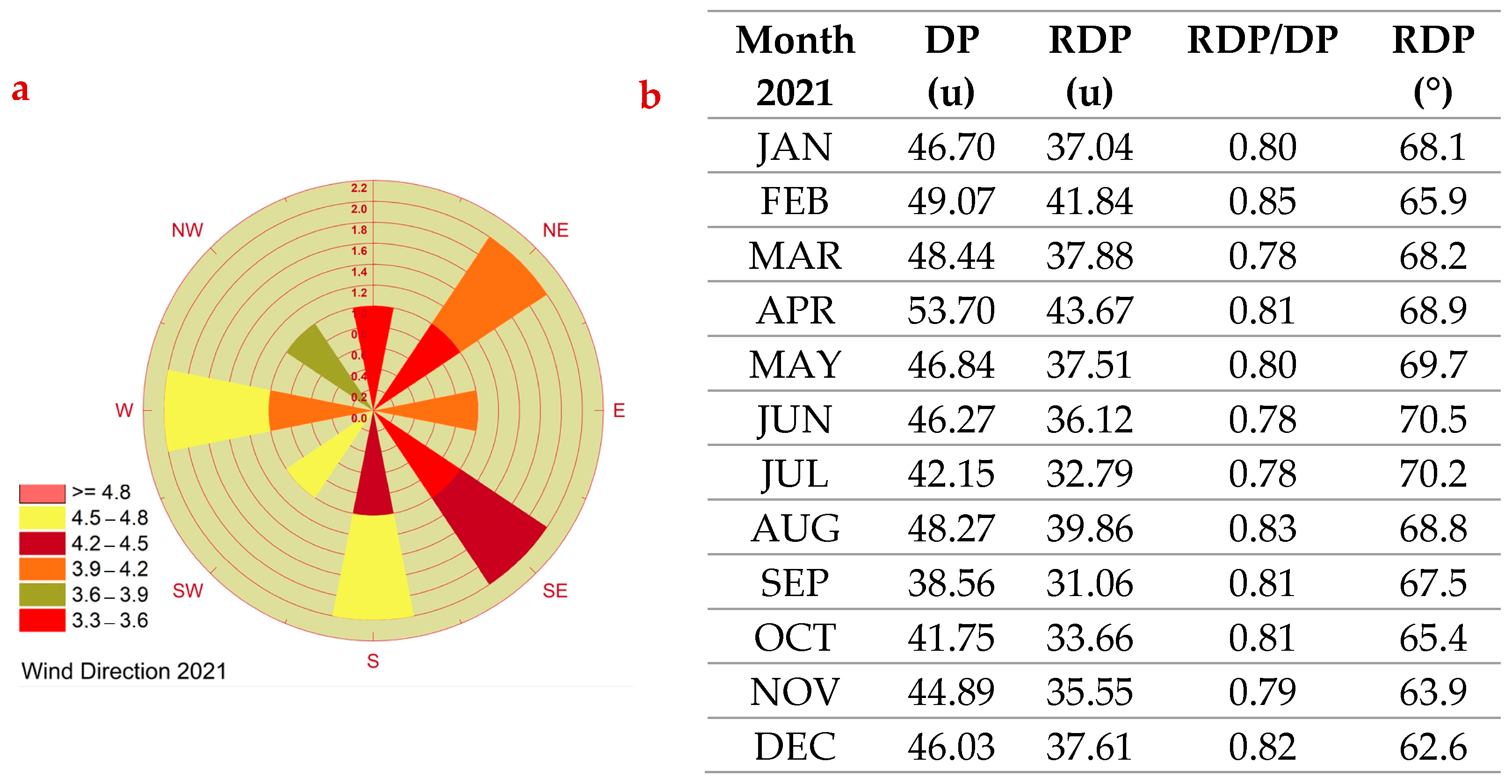


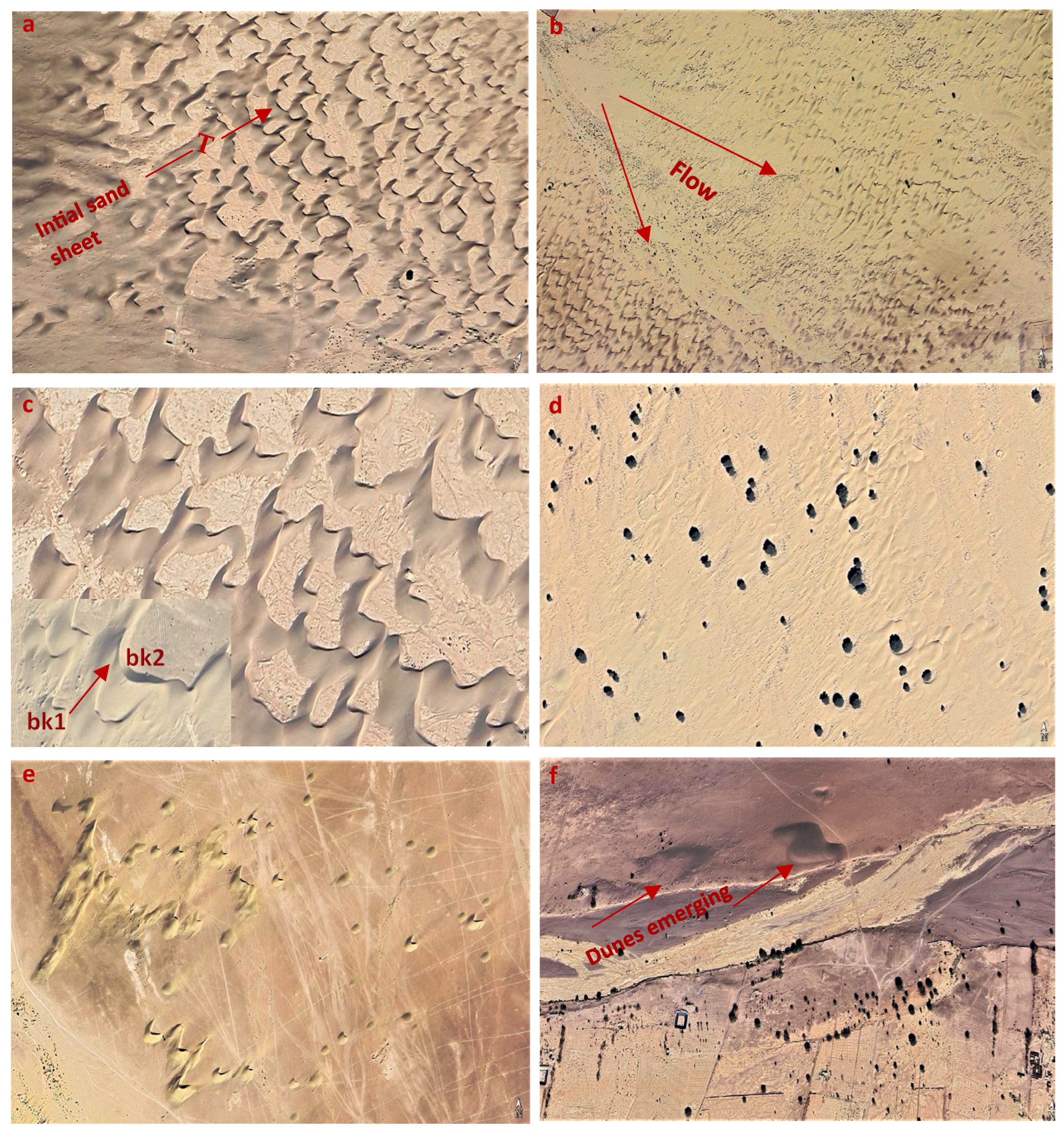
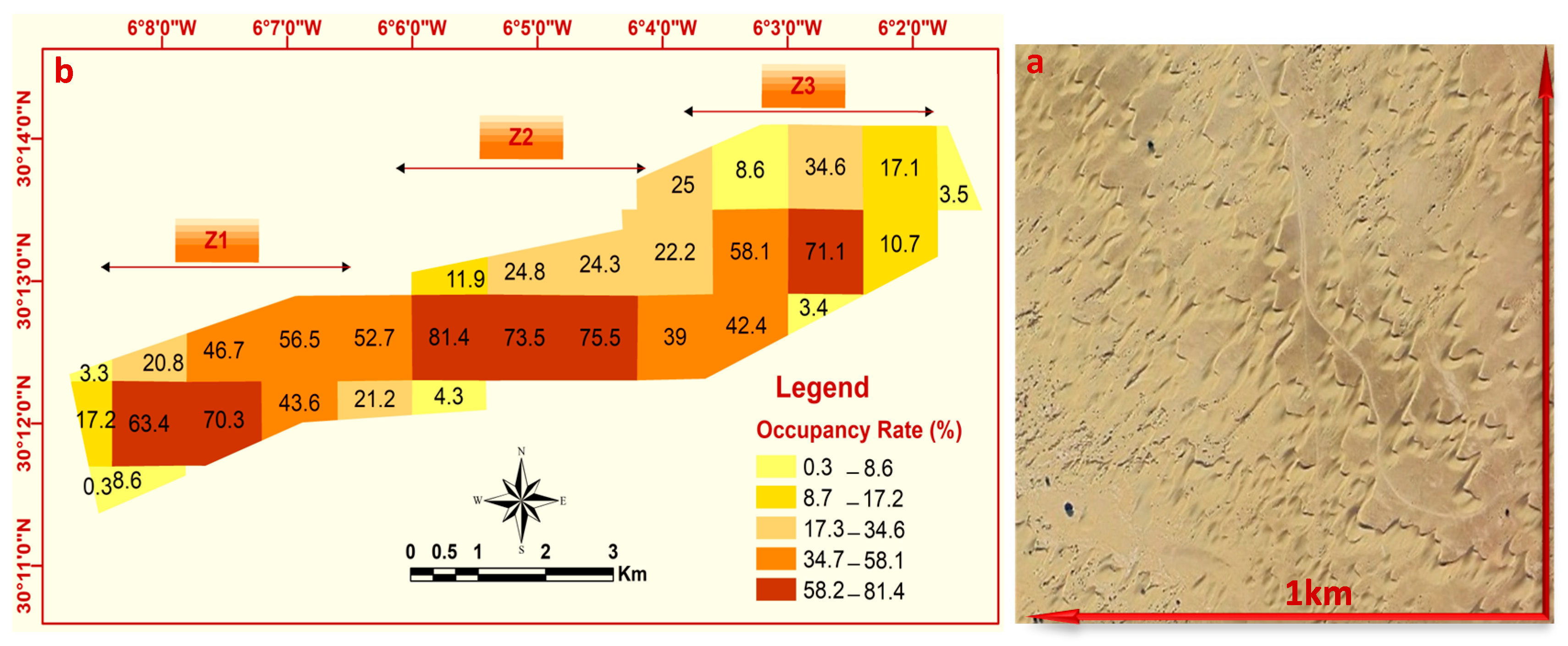
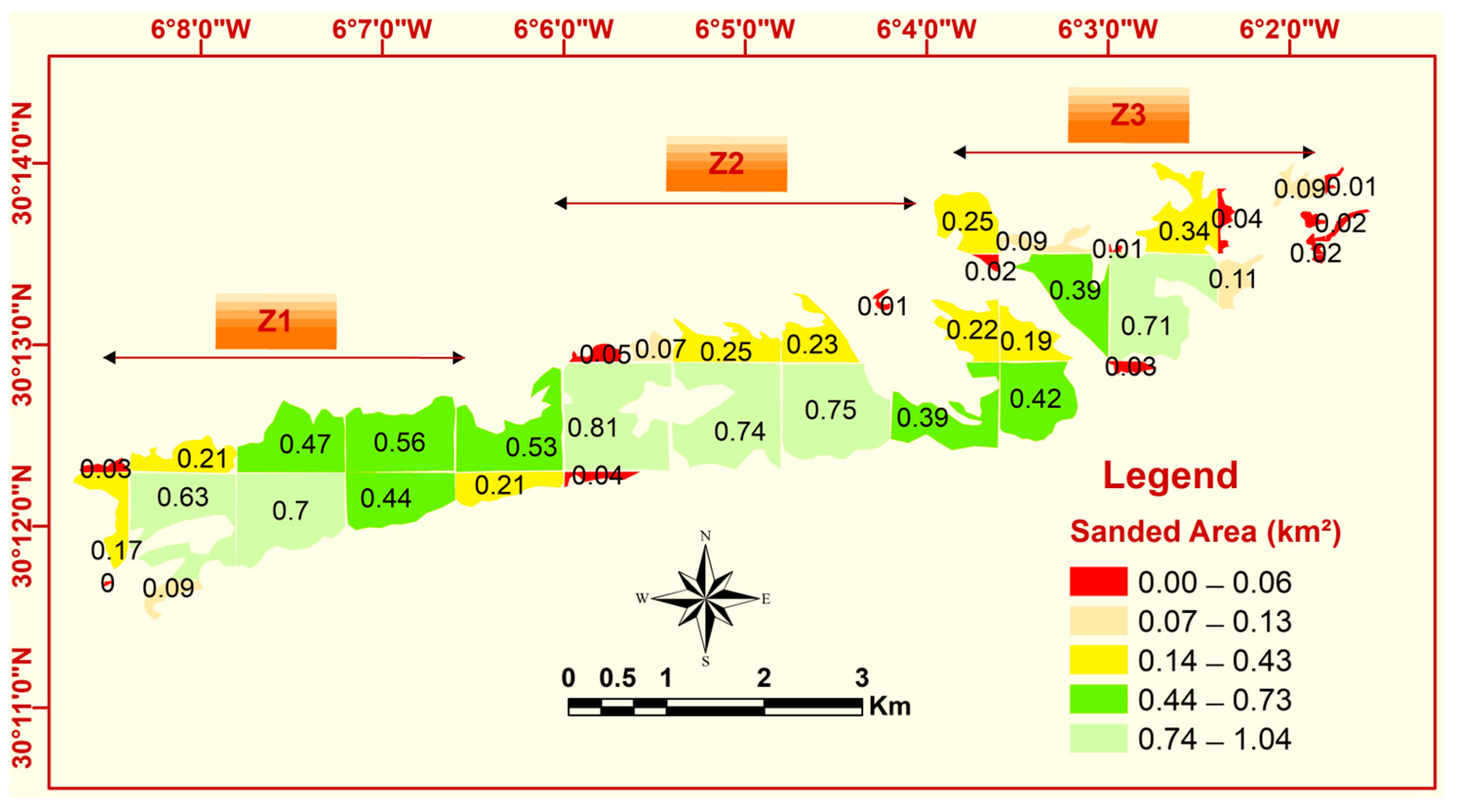


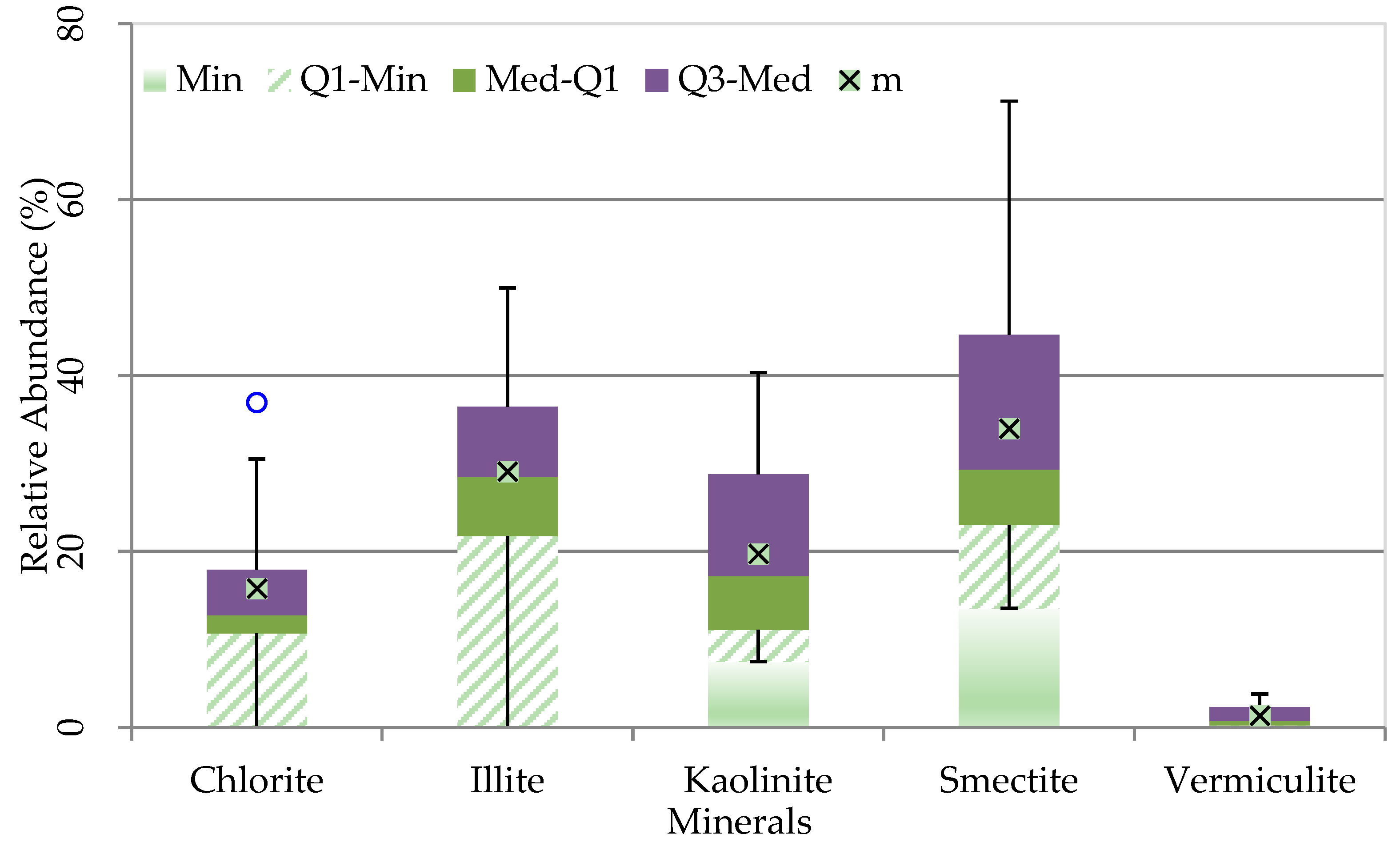



| Patterns | Description |
|---|---|
 | Asymmetric “fat” barchan (c/a ≈ 1.15): form controlled by directional wind distribution; elongated leeward horn conforms to the dominant wind (DW). |
 | Convex sand formation under unidirectional wind regime: features an elongated dextral horn non-conformant with DW, likely due to gravitational effects; slightly asymmetrical. |
 | “Normal” barchanoid dihedral (a/c ≈ 0.68): symmetrical, often isolated in marginal interdune areas or at the Z1 front. |
 | Highly asymmetric barchan: frequently observed throughout the EDF, particularly in northern sections; the stoss slope is tightly arcuate, while the leeward horn elongates considerably (potentially up to 100 m) in the dominant wind direction. |
 | Elongate barchanoid dihedral (a/c ≈ 0.2): rarely present in the EDF landscape; often associated with sections where dunal passages are eroding. |
 | Isolated “fat” barchan (c/a ≈ 1.1): slightly asymmetrical, with obtuse and unequal horns in thickness and length; represents the most generalized barchan form. |
 | Dome dunes: subcircular to elongated elliptical sand mounds, rarely exceeding one meter in height and lacking slip faces; indicative of conditions with low sand supply. |
 | Linear dunes: sparsely observed within the EDF. |
| Zone | Number of Grid Cells (1 Km2 Each) | Total Sand Area (Km2) | Mean Sand Area (ha/Km2) |
|---|---|---|---|
| Z1 | 12 | 4.30 | 36 |
| Z2 | 7 | 3.96 | 57 |
| Z3 | 8 | 1.36 | 17 |
| Variable | Unit | Observations | Minimum | Maximum | Average | Standard Deviation |
|---|---|---|---|---|---|---|
| Mean | µm | 55 | 148.56 | 442.82 | 203.37 | 57.76 |
| Sorting | - | 55 | 1.33 | 2.41 | 1.54 | 0.27 |
| Skewness | - | 55 | −0.54 | 0.22 | −0.14 | 0.13 |
| Kurtosis | - | 55 | 0.55 | 1.52 | 1.05 | 0.19 |
| Parameter | Descriptive Values and Interpretation |
|---|---|
| Overall morphology |  |
| Form ratio (RF) | Ratio of valley width to depth, decreasing from entrance to exit:
|
| Flare angle | Angle formed by the valley walls relative to the longitudinal axis, generally increasing from entrance to exit:
|
| Curvature (RC) | Curvature of the valley walls, generally increasing from entrance to exit:
|
| Symmetry | Asymmetrical, with steeper slopes on the northern side of the valley. Valley wall asymmetry can create additional zones of wind convergence and divergence, reinforcing the Venturi effect. |
| Length | Bird’s-eye length: 80 km. Sufficient valley length allows the Venturi effect to fully develop and intensify along the Feija. |
| Characteristic | Elfeija Dune Field (EDF) | Tarfaya-Laâyoune Field | Erg Chebbi | Erg Chigaga |
|---|---|---|---|---|
| Location and Setting | SE Morocco; intracontinental plateau, topographically constrained. | SW Morocco; Atlantic coastal plain. | SE Morocco; unconstrained basin near Merzouga. | SE Morocco; large depression south of Djebel Bani. |
| Dune Types | Predominantly barchans and coalescent barchanoid ridges. | Barchan corridors and isolated barchans [41,43]. | Large complex star dunes and linear (Seif) dunes [16]. | Complex transverse, barchanoid, and likely star dunes. |
| Dominant Wind Regime | Unimodal (WSW-WNW). RDP/DP ≈ 0.78–0.85. | Unimodal (NNW trade winds). RDP/DP ≈ 0.9. | Bimodal (SW Sirocco and NE Chergui) [16]. | Complex/multimodal, influenced by regional winds and local topography. |
| Scale and Dimensions | Field: ~30 km2. Dune H: ~2.5 m; W: ~30 m. | Field: >100 km long. Dune W: 40–125 m. | Field: ~150 km2. Dune H: up to 150 m. | Field: ~300 km2. Dune H: up to 150 m. |
| Granulometry | Fine to medium sand (150–250 µm). Quartz-dominated with significant calcite. | Fine sand, peak at 175 µm. Quartz and calcite [41,43]. | Not specified; likely well-sorted fine sand. | 1–2 mm (35%),125–250 µm (33%) [42]; likely well-sorted sand. |
| Primary Natural Control | Topographic channeling enhancing a unidirectional wind. | Strong, persistent unidirectional trade wind regime. | Bimodal wind regime promoting vertical accretion. | Large sediment supply and complex wind interactions. |
| Dominant Anthropogenic Impact | Intensive agricultural expansion at dune margins, altering sediment budget. | Limited due to remoteness; some localized infrastructure. | High-impact tourism alters surfaces and local dynamics. | Moderate tourism, less accessible. |
| Classes | Significance and Recommended Actions |
|---|---|
| Class (A) 0–25% |
|
| Class (B) 25–50% |
|
| Class (C) 50–75% |
|
| Class (D) >75% |
|
Disclaimer/Publisher’s Note: The statements, opinions and data contained in all publications are solely those of the individual author(s) and contributor(s) and not of MDPI and/or the editor(s). MDPI and/or the editor(s) disclaim responsibility for any injury to people or property resulting from any ideas, methods, instructions or products referred to in the content. |
© 2025 by the authors. Licensee MDPI, Basel, Switzerland. This article is an open access article distributed under the terms and conditions of the Creative Commons Attribution (CC BY) license (https://creativecommons.org/licenses/by/4.0/).
Share and Cite
Amiha, R.; Kabbachi, B.; Ait Haddou, M.; Quesada-Román, A.; Bouchriti, Y.; Abioui, M. Morphodynamics, Genesis, and Anthropogenically Modulated Evolution of the Elfeija Continental Dune Field, Arid Southeastern Morocco. Earth 2025, 6, 100. https://doi.org/10.3390/earth6030100
Amiha R, Kabbachi B, Ait Haddou M, Quesada-Román A, Bouchriti Y, Abioui M. Morphodynamics, Genesis, and Anthropogenically Modulated Evolution of the Elfeija Continental Dune Field, Arid Southeastern Morocco. Earth. 2025; 6(3):100. https://doi.org/10.3390/earth6030100
Chicago/Turabian StyleAmiha, Rachid, Belkacem Kabbachi, Mohamed Ait Haddou, Adolfo Quesada-Román, Youssef Bouchriti, and Mohamed Abioui. 2025. "Morphodynamics, Genesis, and Anthropogenically Modulated Evolution of the Elfeija Continental Dune Field, Arid Southeastern Morocco" Earth 6, no. 3: 100. https://doi.org/10.3390/earth6030100
APA StyleAmiha, R., Kabbachi, B., Ait Haddou, M., Quesada-Román, A., Bouchriti, Y., & Abioui, M. (2025). Morphodynamics, Genesis, and Anthropogenically Modulated Evolution of the Elfeija Continental Dune Field, Arid Southeastern Morocco. Earth, 6(3), 100. https://doi.org/10.3390/earth6030100









